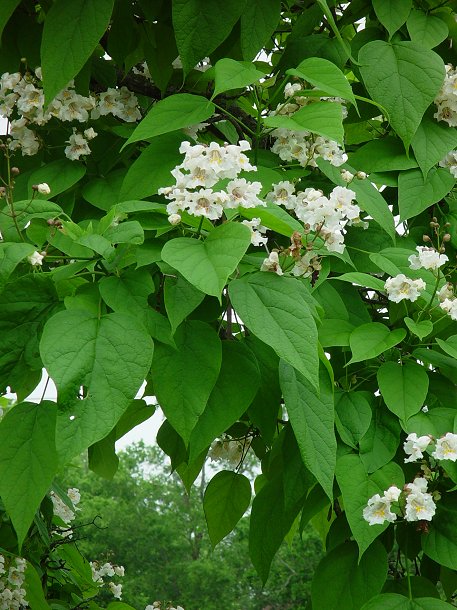Catalpa speciosa Teas
Northern Catalpa

Native
CC = 2
CW = 3
MOC = 41
© DETenaglia
Catalpa speciosa TeasNorthern Catalpa | |
 |
Native CC = 2 CW = 3 MOC = 41 |
© DETenaglia |
|
Family - Bignoniaceae Habit - Tree, to 30 m tall. Stems - Woody, to 1 m in diameter. Bark reddish brown, divided into thick, scaly plates or furrows on older trunks. Leaves - Opposite or in whorls of 3, simple, long petiolate. Blades 15-30 cm long, ovate, entire or less commonly shallowly 3-lobed or 3-angled toward the base, the bases truncate or cordate, noticeably tapered at the tip, the upper surface glabrous, the undersurface persistently pubescent with short, curly, unbranched to stellate hairs, especially along the veins. Inflorescence - Terminal panicles to 20 cm high and broad.
Flowers - Calyces 2-lobed, 9-12 mm long. Corollas zygomorphic, glabrous, 5-lobed, 4-5 cm long, the middle lobe of the lower lip shallowly notched. Corolla white externally, patterned with purple and yellow or orange stripes and markings internally. Stamens 2. Staminodes 3, minute, fused to the corolla tube.
Fruits - Elongate capsules 20-50 cm long, 1.0-1.5 cm in diameter, pendent, relatively thick-walled, the valves remaining concave after dehiscence. Seeds with the body 8-15 mm long, 4-6 mm wide, the hairs of the tufts more or less parallel.
Flowering - May - June. Habitat - Bottomland and mesic forests, streambanks, bases of bluffs, roadsides, railroads, moist disturbed areas. Commonly cultivated. Origin - Native to the Mississippi Lowlands Division of Missouri, cultivated throughout the state. Lookalikes - Catalpa bignonioides. Other info. - speciosa means "showy" and the trees certainly are when in bloom. The panicles of this species are fewer flowered and shorter than the closely related C. bignonioides, but the flowers are larger and appear more dense in bloom. The two can be difficult to distinguish. The common term "cigar tree" derives from the appearance of the fruits. This attractive species is often cultivated, which has somewhat obscured its natural range. Beyond Missouri it occurs across much of the continental U.S., most frequently in Midwestern states. Photograph taken in Lebanon, TN., 5-16-03 (DETenaglia); also in Hermann, Gasconade County, MO, 9-11-2010, St. Joe State Park, St. Francois County, MO, 5-25-2010, and Hodgson Mill, Ozark County, MO, 5-3-2012 (SRTurner). |